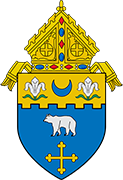History of the Diaconate
The diaconate had its origin in the first century when the early Church was being established and a need for catechesis and service to others was recognized. After flourishing for 400 years, the diaconate declined and became little more than a transitional step to priesthood. The Second Vatican Council, held 1962-65, restored this ministry of service to its original purpose.
Deacons share in the sacrament of Orders with bishops and priests. In the United States, there are more than 13,000 deacons serving primarily in parishes. The work of the deacon is defined as ministry of Liturgy, Word and Charity.
Liturgy
The deacon assists the priest at Mass. He may administer the sacrament of Baptism, witness and bless marriages, officiate at funerals and burial services, minister at the Exposition of the Blessed Sacrament and preside at Communion liturgies where a priest is not present. This service at the altar is a sign and symbol of the Church’s commitment to those in the parish and the community.
Word
The deacon proclaims the Gospel, the Good News. He may receive from his bishop the faculty or authority to preach. His reading of the gospel in Church is only one aspect of proclaiming the word of God. The deacon endeavors to turn the Word into deed in his daily life.
Charity
This ministry of love and justice is the heart of the diaconate. In Kansas City-St. Joseph, about 60 deacons serving in parishes also are involved as hospital and prison chaplains, assist the homeless on the streets and in soup kitchens, minister to the divorced and widowed, advance pro-life causes, and counsel and serve, particularly those who are on the margins of society.
The deacon’s response is not to move away from the secular world, but to become more involved in it. His daily dress is not different, but his manner of living demonstrates a caring for others and a living expression of the gospel of Jesus.

